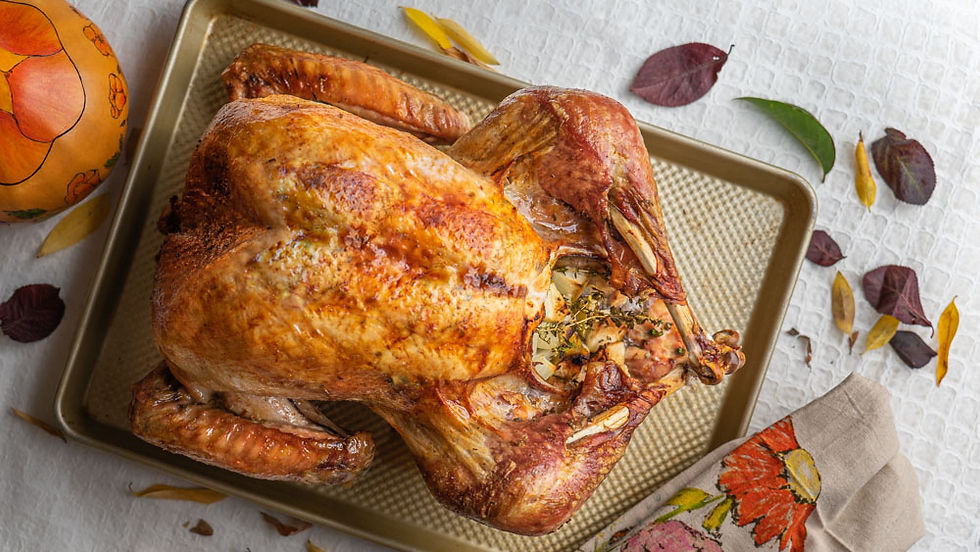When I began to research how to cook a Heritage Turkey, I was surprised to find that the majority of recipes recommend high-heat cooking and to only cook the turkey to 140F internal temperature, but it was no surprise that not one recipe mentioned Convection.
Most recipes also suggested brining the bird as well as using generous amounts of butter to help keep the bird juicy. Given the high cooking temperature in the drying radiant heat brining and adding plenty of fat made perfect sense, but I decided to take a leap of faith and use a method more suited to cooking with Convection.
What is Different About a Heritage Turkey?
Heritage turkeys are bred naturally, they take longer to develop and spend their lives in nature running around and developing big strong legs, and the meat that is mostly dark and very flavorful. They certainly look different from a factory-bred turkey, and while the taste is similar it is definitely richer and more flavorful.
Heritage turkeys may not have such a large breast but there was still plenty of while meat and a 13lb turkey will easily feed 6 people and have leftovers.
How Can I Order a Heritage Turkey?
Heritage turkeys are mostly ordered online directly from producers; they are definitely more expensive and a shipping cost for 2nd-day air also adds to the cost. The producer may offer a selection of Heritage birds so you can try different ones.
Cooking a Heritage Turkey in Convection
Cooking a Heritage turkey in Convection is quite simple. The first step is to get the bird to room temperature. I defrosted my 13lb turkey for three days in the refrigerator, and it was still icy in places. To get that last icy bit out of the bird, I find using the Defrost cycle in my Convection or Steam oven for about 20 minutes works best.
It is quite safe to use the Defrost mode as it does not cook the food, the fan just circulates the ambient air in the oven to dissolve any ice. However, large roasts like turkey should always first be defrosted in the refrigerator, and the Defrost Mode used only to get it to room temperature. When using the Defrost Mode place the turkey on a rack in a shallow pan to capture the ice as it dissolves.
The next important step is to plan to roast the turkey on a rack in a shallow pan. You can see from the video I used a shallow-rimmed baking pan with a cookie cooling rack (Read my blog: Preparing for Holiday Cooking - All About Roasting Pans and Meat Probes) and it worked perfectly. Roasting the turkey on a rack helps keep the juices in the bird. And once the cooked bird has rested for about 30 minutes, you can pick it up with two kitchen towels and drain out the liquid to add to the stock for gravy. Be sure to carve it on a rimmed board as more juice will flow during carving.
For extra drippings, I added two cups of chicken stock to the base of the roasting pan, once the pan was in the oven. When the bird came out of the oven I moved it to another pan to rest and deglazed the roasting pan adding those drippings to the stock for the gravy.
Convection Temperature and Timing
For best results, start the cooking at 400 F (204 C) degrees for 15 minutes, then lower the temperature to 325 F (163 C) for the remainder of the cooking time. Remember in Convection, heat circulates around the oven cooking from the edge to the center, so the lower cooking temperature ensures even cooking.
The turkey can be roasted in either the Convection Roast or Convection Bake mode if your oven doesn’t have a Convection Roast Mode.
Timing the cooking is important because a turkey in the 12 - 15lb range will cook in just under two hours. If your oven is equipped with a meat probe then I would recommend using it otherwise check the bird after it has cooked for an hour and forty minutes with an instant-read thermometer to determine the internal temperature.
Even though most recipes I read said to cook the bird to an internal temperature of 140 F (60 C) I found I needed to cook my bird to 150 F (66 C) but I wouldn’t go beyond 160F (71 C), remember the internal temperature continues to rise while the bird is resting.
When poultry is cooked on a rack in Convection it retains more moisture and you may find the area around the bone will be red. Don’t be alarmed, if the meat is cooked this redness is perfectly safe, it is due to the turkey not losing so much juice during the cooking.
You will find more specific details in the recipe but I hope this information will help guide you to success if you are planning on cooking a Heritage turkey this Thanksgiving. It is more expensive but very worthwhile and we were very pleased with the results.
In my next post I will review the method for roasting a turkey in the spatchcock style, cutting out that back bone takes some work but the cooking and carving is so easy and the results are just outstanding.
Larissa, Your Convection Enthusiast









You have officially saved Thanksgiving for us! haha :) Finding convection oven recipes has been a struggle these past few years...so I thought I'd give it one last try to see if I can make my very first heritage turkey moist and delicious this year. I'll come back and let you know how it tasted - thank you again, I really appreciate your guidance on this!!